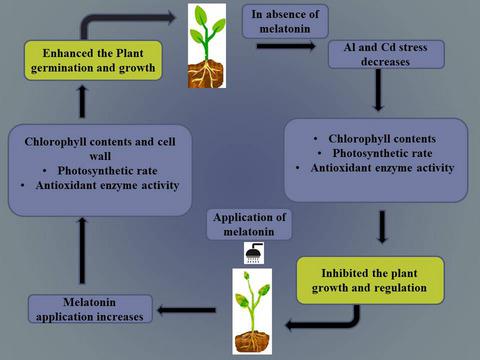当前位置:
X-MOL 学术
›
Plant Biol.
›
论文详情
Our official English website, www.x-mol.net, welcomes your feedback! (Note: you will need to create a separate account there.)
Melatonin mitigates cadmium and aluminium toxicity through modulation of antioxidant potential in Brassica napus L.
Plant Biology ( IF 3.9 ) Pub Date : 2020-01-30 , DOI: 10.1111/plb.13093 A Sami 1 , F A Shah 2 , M Abdullah 3 , X Zhou 1 , Y Yan 1 , Z Zhu 1 , K Zhou 1
中文翻译:

褪黑素通过调节甘蓝型油菜的抗氧化能力来减轻镉和铝的毒性。
更新日期:2020-01-30
Plant Biology ( IF 3.9 ) Pub Date : 2020-01-30 , DOI: 10.1111/plb.13093 A Sami 1 , F A Shah 2 , M Abdullah 3 , X Zhou 1 , Y Yan 1 , Z Zhu 1 , K Zhou 1
Affiliation

|
- Melatonin has emerged as an essential molecule in plants, due to its role in defence against metal toxicity. Aluminium (Al) and cadmium (Cd) toxicity inhibit rapeseed seedling growth.
- In this study, we applied different doses of melatonin (50 and 100 µm ) to alleviate Al (25 µm ) and Cd (25 µm ) stress in rapeseed seedlings. Results show that Al and Cd caused toxicity in rapeseed seedling, as evidenced by a decrease in height, biomass and antioxidant enzyme activity.
- Melatonin increased the expression of melatonin biosynthesis‐related Brassica napus genes for caffeic acid O‐methyl transferase (BnCOMT ) under Al and Cd stress. The genes BnCOMT‐1 , BnCOMT‐5 and BnCOMT‐8 showed up‐regulated expression, while BnCOMT‐4 and BnCOMT‐6 were down‐regulated during incubation in water. Melatonin application increased the germination rate, shoot length, root length, fresh and dry weight of seedlings. Melatonin supplementation under Al and Cd stress increased superoxide dismutase, catalase, peroxidase, ascorbate peroxidase, proline, chlorophyll and anthocyanin content, as well as photosynthesis rate. Both Cd and Al treatments significantly increased hydrogen peroxide and malondialdehyde levels in rapeseed seedlings, which were strictly counterbalanced by melatonin. Analysis of Cd and Al in different subcellular compartments showed that melatonin enhanced cell wall and soluble fractions, but reduced the vacuolar and organelle fractions in Al‐ and Cd‐treated seedlings.
- These results suggest that melatonin‐induced improvements in antioxidant potential, biomass, photosynthesis rate and successive Cd and Al sequestration play a pivotal role in plant tolerance to Al and Cd stress. This mechanism may have potential implications in safe food production.
中文翻译:

褪黑素通过调节甘蓝型油菜的抗氧化能力来减轻镉和铝的毒性。
- 褪黑素由于具有防御金属毒性的作用,已成为植物中不可或缺的分子。铝(Al)和镉(Cd)的毒性会抑制油菜籽幼苗的生长。
- 在这项研究中,我们应用了不同剂量的褪黑激素(50和100 µm)来减轻油菜幼苗中的Al(25 µm)和Cd(25 µm)胁迫。结果表明,铝和镉对油菜籽幼苗有毒作用,其高度,生物量和抗氧化酶活性的降低证明了这一点。
- 褪黑素增加了Al和Cd胁迫下与咖啡酸O-甲基转移酶(BnCOMT)褪黑素生物合成相关的甘蓝型油菜基因的表达。基因BnCOMT-1,BnCOMT-5和BnCOMT-8表现出上调的表达,而BnCOMT-4和BnCOMT -6-在水中孵育期间被下调。褪黑素的使用增加了种子的发芽率,芽长,根长,幼苗的鲜重和干重。在Al和Cd胁迫下补充褪黑激素可增加超氧化物歧化酶,过氧化氢酶,过氧化物酶,抗坏血酸过氧化物酶,脯氨酸,叶绿素和花色苷的含量,以及光合作用速率。镉和铝处理均显着增加了油菜籽幼苗中的过氧化氢和丙二醛水平,而褪黑激素则严格地抵消了该水平。对不同亚细胞区室中的Cd和Al的分析表明,褪黑素增强了Al和Cd处理的幼苗的细胞壁和可溶性部分,但降低了液泡和细胞器部分。
- 这些结果表明,褪黑素诱导的抗氧化能力,生物量,光合作用速率的改善以及连续的Cd和Al隔离对植物对Al和Cd胁迫的耐受性起着关键作用。该机制可能对安全食品生产产生潜在影响。



























 京公网安备 11010802027423号
京公网安备 11010802027423号